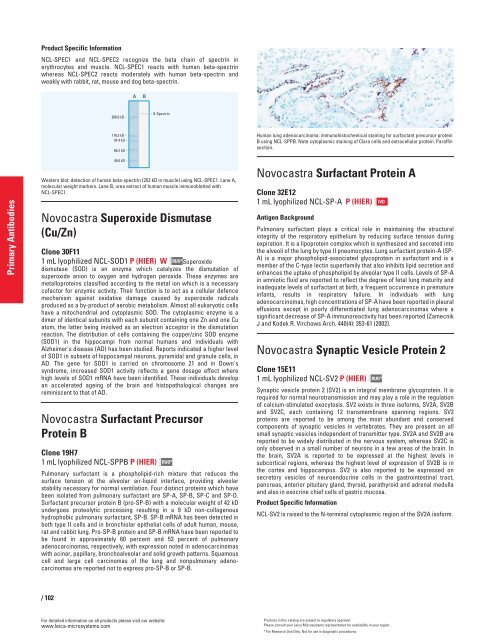QF0159 Marketing Release Record
QF0159 Marketing Release Record
QF0159 Marketing Release Record
Create successful ePaper yourself
Turn your PDF publications into a flip-book with our unique Google optimized e-Paper software.
Primary Antibodies<br />
Product Specific Information<br />
NCL-SPEC1 and NCL-SPEC2 recognize the beta chain of spectrin in<br />
erythrocytes and muscle. NCL-SPEC1 reacts with human beta-spectrin<br />
whereas NCL-SPEC2 reacts moderately with human beta-spectrin and<br />
weakly with rabbit, rat, mouse and dog beta-spectrin.<br />
Western blot: detection of human beta-spectrin (253 kD in muscle) using NCL-SPEC1. Lane A,<br />
molecular weight markers. Lane B, urea extract of human muscle immunoblotted with<br />
NCL-SPEC1.<br />
Novocastra Superoxide Dismutase<br />
(Cu/Zn)<br />
Clone 30F11<br />
1 mL lyophilized NCL-SOD1 P (HIER) W RUO* Superoxide<br />
dismutase (SOD) is an enzyme which catalyzes the dismutation of<br />
superoxide anion to oxygen and hydrogen peroxide. These enzymes are<br />
metalloproteins classified according to the metal ion which is a necessary<br />
cofactor for enzymic activity. Their function is to act as a cellular defence<br />
mechanism against oxidative damage caused by superoxide radicals<br />
produced as a by-product of aerobic metabolism. Almost all eukaryotic cells<br />
have a mitochondrial and cytoplasmic SOD. The cytoplasmic enzyme is a<br />
dimer of identical subunits with each subunit containing one Zn and one Cu<br />
atom, the latter being involved as an electron acceptor in the dismutation<br />
reaction. The distribution of cells containing the copper/zinc SOD enzyme<br />
(SOD1) in the hippocampi from normal humans and individuals with<br />
Alzheimer's disease (AD) has been studied. Reports indicated a higher level<br />
of SOD1 in subsets of hippocampal neurons, pyramidal and granule cells, in<br />
AD. The gene for SOD1 is carried on chromosome 21 and in Down's<br />
syndrome, increased SOD1 activity reflects a gene dosage effect where<br />
high levels of SOD1 mRNA have been identified. These individuals develop<br />
an accelerated ageing of the brain and histopathological changes are<br />
reminiscent to that of AD.<br />
Novocastra Surfactant Precursor<br />
Protein B<br />
Clone 19H7<br />
1 mL lyophilized NCL-SPPB P (HIER)<br />
Pulmonary surfactant is a phospholipid-rich mixture that reduces the<br />
surface tension at the alveolar air-liquid interface, providing alveolar<br />
stability necessary for normal ventilation. Four distinct proteins which have<br />
been isolated from pulmonary surfactant are SP-A, SP-B, SP-C and SP-D.<br />
Surfactant precursor protein B (pro-SP-B) with a molecular weight of 42 kD<br />
undergoes proteolytic processing resulting in a 9 kD non-collagenous<br />
hydrophobic pulmonary surfactant, SP-B. SP-B mRNA has been detected in<br />
both type II cells and in bronchiolar epithelial cells of adult human, mouse,<br />
rat and rabbit lung. Pro-SP-B protein and SP-B mRNA have been reported to<br />
be found in approximately 60 percent and 53 percent of pulmonary<br />
adenocarcinomas, respectively, with expression noted in adenocarcinomas<br />
with acinar, papillary, bronchoalveolar and solid growth patterns. Squamous<br />
cell and large cell carcinomas of the lung and nonpulmonary adenocarcinomas<br />
are reported not to express pro-SP-B or SP-B.<br />
/ 102<br />
For detailed information on all products please visit our website:<br />
www.leica-microsystems.com<br />
RUO*<br />
Human lung adenocarcinoma: immunohistochemical staining for surfactant precursor protein<br />
B using NCL-SPPB. Note cytoplasmic staining of Clara cells and extracellular protein. Paraffin<br />
section.<br />
Novocastra Surfactant Protein A<br />
Clone 32E12<br />
1 mL lyophilized NCL-SP-A P (HIER)<br />
Antigen Background<br />
Pulmonary surfactant plays a critical role in maintaining the structural<br />
integrity of the respiratory epithelium by reducing surface tension during<br />
expiration. It is a lipoprotein complex which is synthesized and secreted into<br />
the alveoli of the lung by type II pneumocytes. Lung surfactant protein-A (SP-<br />
A) is a major phospholipid-associated glycoprotein in surfactant and is a<br />
member of the C-type lectin superfamily that also inhibits lipid secretion and<br />
enhances the uptake of phospholipid by alveolar type II cells. Levels of SP-A<br />
in amniotic fluid are reported to reflect the degree of fetal lung maturity and<br />
inadequate levels of surfactant at birth, a frequent occurrence in premature<br />
infants, results in respiratory failure. In individuals with lung<br />
adenocarcinomas, high concentrations of SP-A have been reported in pleural<br />
effusions except in poorly differentiated lung adenocarcinomas where a<br />
significant decrease of SP-A immunoreactivity has been reported (Zamecnik<br />
J and Kodek R. Virchows Arch. 440(4): 353-61 (2002).<br />
Novocastra Synaptic Vesicle Protein 2<br />
Clone 15E11<br />
1 mL lyophilized NCL-SV2 P (HIER)<br />
Synaptic vesicle protein 2 (SV2) is an integral membrane glycoprotein. It is<br />
required for normal neurotransmission and may play a role in the regulation<br />
of calcium-stimulated exocytosis. SV2 exists in three isoforms, SV2A, SV2B<br />
and SV2C, each containing 12 transmembrane spanning regions. SV2<br />
proteins are reported to be among the most abundant and conserved<br />
components of synaptic vesicles in vertebrates. They are present on all<br />
small synaptic vesicles independent of transmitter type. SV2A and SV2B are<br />
reported to be widely distributed in the nervous system, whereas SV2C is<br />
only observed in a small number of neurons in a few areas of the brain. In<br />
the brain, SV2A is reported to be expressed at the highest levels in<br />
subcortical regions, whereas the highest level of expression of SV2B is in<br />
the cortex and hippocampus. SV2 is also reported to be expressed on<br />
secretory vesicles of neuroendocrine cells in the gastrointestinal tract,<br />
pancreas, anterior pituitary gland, thyroid, parathyroid and adrenal medulla<br />
and also in exocrine chief cells of gastric mucosa.<br />
Product Specific Information<br />
NCL-SV2 is raised to the N-terminal cytoplasmic region of the SV2A isoform.<br />
IVD<br />
RUO*<br />
Products in this catalog are subject to regulatory approval.<br />
Please consult your Leica Microsystems representative for availability in your region.<br />
* For Research Use Only. Not for use in diagnostic procedures.
















